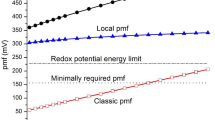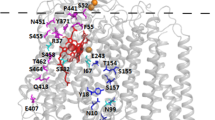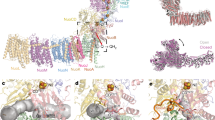Abstract
Electron transfer in cell respiration is coupled to proton translocation across mitochondrial and bacterial membranes, which is a primary event of biological energy transduction. The resulting electrochemical proton gradient is used to power energy-requiring reactions, such as ATP synthesis. Cytochrome c oxidase is a key component of the respiratory chain, which harnesses dioxygen as a sink for electrons and links O2 reduction to proton pumping1. Electrons from cytochrome c are transferred sequentially to the O2 reduction site of cytochrome c oxidase via two other metal centres, CuA and haem a, and this is coupled to vectorial proton transfer across the membrane by a hitherto unknown mechanism. On the basis of the kinetics of proton uptake and release on the two aqueous sides of the membrane, it was recently suggested that proton pumping by cytochrome c oxidase is not mechanistically coupled to internal electron transfer2. Here we have monitored translocation of electrical charge equivalents as well as electron transfer within cytochrome c oxidase in real time. The results show that electron transfer from haem a to the O2 reduction site initiates the proton pump mechanism by being kinetically linked to an internal vectorial proton transfer. This reaction drives the proton pump and occurs before relaxation steps in which protons are taken up from the aqueous space on one side of the membrane and released on the other2.
This is a preview of subscription content, access via your institution
Access options
Subscribe to this journal
Receive 51 print issues and online access
$199.00 per year
only $3.90 per issue
Buy this article
- Purchase on Springer Link
- Instant access to full article PDF
Prices may be subject to local taxes which are calculated during checkout



Similar content being viewed by others
References
Wikström, M. K. F. Proton pump coupled to cytochrome c oxidase in mitochondria. Nature 266, 271–273 (1977)
Faxén, K., Gilderson, G., Ädelroth, P. & Brzezinski, P. A mechanistic principle for proton pumping by cytochrome c oxidase. Nature 437, 286–289 (2005)
Babcock, G. T. & Wikström, M. O2 activation and the conservation of energy in cell respiration. Nature 356, 301–309 (1992)
Ferguson-Miller, S. & Babcock, G. T. Heme/copper terminal oxidases. Chem. Rev. 96, 2889–2907 (1996)
Gennis, R. B. Coupled proton and electron transfer reactions in cytochrome oxidase. Front. Biosci. 9, 581–591 (2004)
Wikström, M. Proton translocation by bacteriorhodopsin and heme-copper oxidases. Curr. Opin. Struct. Biol. 8, 480–488 (1998)
Morgan, J. E., Verkhovsky, M. I., Palmer, G. & Wikström, M. The role of the PR intermediate in the reaction of cytochrome c oxidase with O2 . Biochemistry 40, 6882–6892 (2001)
Jasaitis, A., Verkhovskaya, M., Morgan, J. E., Verkhovsky, M. & Wikström, M. Assignment and charge translocation stoichiometries of the major electrogenic phases in the reaction of cytochrome c oxidase with dioxygen. Biochemistry 38, 2697–2706 (1999)
Bloch, D. et al. The catalytic cycle of cytochrome c oxidase is not the sum of its two halves. Proc. Natl Acad. Sci. USA 101, 529–533 (2004)
Namslauer, A., Aagaard, A., Katsonouri, A. & Brzezinski, P. Intramolecular proton transfer reactions in a membrane-bound proton pump: the effect of pH on the peroxy to ferryl transition in cytochrome c oxidase. Biochemistry 42, 1488–1498 (2003)
Mitchell, R. & Rich, P. R. Proton uptake by cytochrome c oxidase on reduction and on ligand binding. Biochim. Biophys. Acta 1186, 19–26 (1994)
Ruitenberg, M., Kannt, A., Bamberg, E., Fendler, K. & Michel, H. Reduction of cytochrome c oxidase by a second electron leads to proton translocation. Nature 417, 99–102 (2002)
Iwata, S., Ostermeier, C., Ludwig, B. & Michel, H. Structure at 2.8 Å resolution of cytochrome c oxidase from Paracoccus denitrificans. Nature 376, 660–669 (1995)
Brändén, G. et al. The protonation state of a heme propionate controls electron transfer in cytochrome c oxidase. Biochemistry 44, 10466–10474 (2005)
Ädelroth, P., Svensson-Ek, M., Mitchell, D. M., Gennis, R. B. & Brzezinski, P. Glutamate 286 in cytochrome aa 3 from Rhodobacter sphaeroides is involved in proton uptake during the reaction of the fully reduced enzyme with dioxygen. Biochemistry 36, 13824–13829 (1997)
Thomas, J. W., Puustinen, A., Alben, J. O., Gennis, R. B. & Wikström, M. Substitution of asparagine for aspartate 135 in subunit I of the cytochrome bo ubiquinol oxidase of Escherichia coli eliminates proton pumping activity. Biochemistry 32, 10923–10928 (1993)
Babcock, G. T. How oxygen is activated and reduced in respiration. Proc. Natl Acad. Sci. USA 96, 12971–12973 (1999)
Verkhovsky, M. I., Jasaitis, A., Verkhovskaya, M. L., Morgan, J. E. & Wikström, M. Proton translocation by cytochrome c oxidase. Nature 400, 480–483 (1999)
Verkhovskaya, M. L. et al. Glutamic acid 286 in subunit I of cytochrome bo 3 is involved in proton translocation. Proc. Natl Acad. Sci. USA 94, 10128–10131 (1997)
Michel, H. Cytochrome c oxidase: catalytic cycle and mechanism of proton pumping - a discussion. Biochemistry 38, 15129–15140 (1999)
Wikström, M., Verkhovsky, M. I. & Hummer, G. Water-gated mechanism of proton translocation by cytochrome c oxidase. Biochim. Biophys. Acta 1604, 61–65 (2003)
Popovic, D. M. & Stuchebrukhov, A. A. Proton pumping mechanism and catalytic cycle of cytochrome c oxidase: Coulomb pump model with kinetic gating. FEBS Lett. 566, 126–130 (2004)
Lanyi, J. K. & Luecke, H. Bacteriorhodopsin. Curr. Opin. Struct. Biol. 11, 415–419 (2001)
Siegbahn, P. E. M., Blomberg, M. R. A. & Blomberg, M. L. Theoretical study of the energetics of proton pumping and oxygen reduction in cytochrome oxidase. J. Phys. Chem. B 107, 10946–10955 (2003)
Flöck, D. & Helms, V. Protein-protein docking of electron transfer complexes: cytochrome c oxidase and cytochrome c. Proteins 47, 75–85 (2002)
Tsukihara, T. et al. The low spin heme of cytochrome c oxidase as the driving element of the proton-pumping process. Proc. Natl Acad. Sci. USA 100, 15304–15309 (2003)
Humphrey, W., Dalke, A. & Schulten, K. VMD: Visual molecular dynamics. J. Mol. Graph. 14, 33–38 (1996)
Yoshikawa, S. et al. Redox-coupled crystal structural changes in bovine heart cytochrome c oxidase. Science 280, 1723–1729 (1998)
Buse, G., Soulimane, T., Dewor, M., Meyer, H. E. & Bluggel, M. Evidence for a copper-coordinated histidine-tyrosine cross-link in the active site of cytochrome oxidase. Protein Sci. 8, 985–990 (1999)
Acknowledgements
We thank L. Laakkonen for help in preparing Fig. 1, and A. Puustinen and C. Ribacka for providing samples of wild-type and mutant enzyme. This work was supported by grants from the Sigrid Jusélius Foundation, Biocentrum Helsinki and the Academy of Finland (programme 44895).
Author information
Authors and Affiliations
Corresponding author
Ethics declarations
Competing interests
Reprints and permissions information is available at npg.nature.com/reprintsandpermissions. The authors declare no competing financial interests.
Supplementary information
Supplementary Figures
Charge translocation in the E278Q mutant enzyme. (PDF 41 kb)
Supplementary Figure Legends
This contains the legend to the Supplementary Figure. (DOC 21 kb)
Rights and permissions
About this article
Cite this article
Belevich, I., Verkhovsky, M. & Wikström, M. Proton-coupled electron transfer drives the proton pump of cytochrome c oxidase. Nature 440, 829–832 (2006). https://doi.org/10.1038/nature04619
Received:
Accepted:
Issue Date:
DOI: https://doi.org/10.1038/nature04619
This article is cited by
-
Biophysical control of plasticity and patterning in regeneration and cancer
Cellular and Molecular Life Sciences (2024)
-
Linking extreme seasonality and gene expression in Arctic marine protists
Scientific Reports (2023)
-
Extracellular ATP-induced calcium oscillations regulating the differentiation of osteoblasts through aerobic oxidation metabolism pathways
Journal of Bone and Mineral Metabolism (2023)
-
Photobiomodulation as an antioxidant substitute in post-thawing trauma of human stem cells from the apical papilla
Scientific Reports (2021)
-
Architecture of bacterial respiratory chains
Nature Reviews Microbiology (2021)
Comments
By submitting a comment you agree to abide by our Terms and Community Guidelines. If you find something abusive or that does not comply with our terms or guidelines please flag it as inappropriate.



